When you open a marketplace in order to buy something you might wonder if you can build a similar site, an ideal platform where buyers may purchase products from sellers and you get a commission on sales. The idea of launching your own marketplace may seem a little daunting and confusing due to a lot of technical aspects you need to take into account. However, everything is possible, and with the right tools, it can be much easier than you think.
Being quite knowledgable about marketplaces, we want to share with you our insight into the area. That is, what a marketplace is, how it works, what makes it different from other platforms, and what you need to have in order to launch your own marketplace.

What is a marketplace?
A marketplace is an online platform where buyers may browse multiple products offered by sellers, purchase them online and get them delivered with available shipping methods. Sellers and buyers may interact with each other — ask questions, leave comments, and rate both products and sellers.
A marketplace is sometimes compared to a shop window, where all products available for sale are presented. The products showcased on a marketplace can be very diverse and include electronics, cosmetics, clothing, tools, handmade products, digital products, etc. In addition, a marketplace can be a platform for the promotion of services, including highly specialized ones, for example, a financial or consulting marketplace.
At the same time, a marketplace is not an online store, where the owner of the website and the seller of the products is the same company. A marketplace is a platform where plenty of different independent sellers offer their products. And while the online store is focused mainly on the promotion of its own products and the development of its own business, the marketplace aims to expand the number of its clients and boost sales of all products presented on it. Moreover, online stores usually have premises with all their products available for browsing and buying. Marketplaces, in their turn, have pick-up points only.
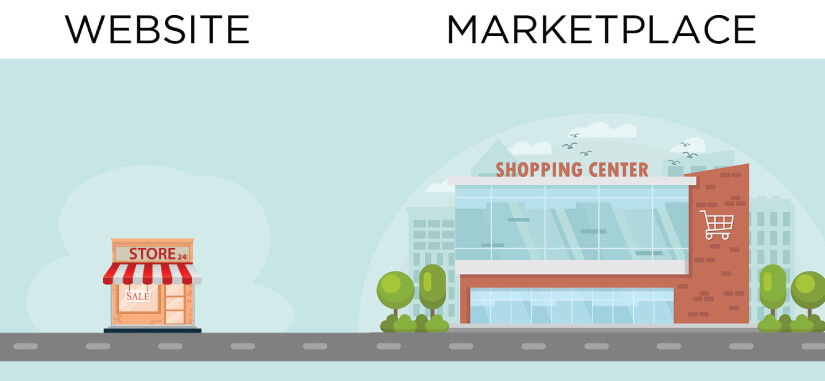
There are usually three types of participants on the marketplace:
- B2B — companies sell their products or services to other companies;
- B2C — companies sell their products or services to people;
- C2C — people (who are not entrepreneurs) sell their products or services to other people.
The types of products and the amount of sales significantly depend on the type of marketplace participants. Therefore, when launching such a resource, it is important that you decide who will be your sellers and buyers — people or companies.
Marketplace fulfillment methods
Different marketplaces use different methods to build their relationships with sellers. There are three major methods:
FBS (Fulfillment by Seller) — The seller prepares, packs, and delivers his products to the marketplace’s point of reception. In this case, the marketplace serves as a shop window for products, promotes them, and delivers orders to buyers.
FBO (Fulfillment by Operator) — The seller sends his products to the marketplace. The marketplace collects, packs, stores, and delivers the products to end customers.
DBS (Delivery by Seller) — The seller has full control over the entire chain of products. In other words, he prepares, packs, and delivers his products to end customers. In this case, the marketplace serves only as a shop window.
Sometimes marketplaces combine the methods described above and create their own unique models.
Whichever of these methods of working with sellers you choose, you need to create clear logistics mechanisms to ensure that all relevant processes are in place.
What you need to start your own marketplace?
Idea and concept
Think about what kind of marketplace you would like to build. Ask yourself the following questions,
- What products will be sold on my marketplace?
- Who might be interested in these products?
- What are the needs of my future sellers and buyers?
- What will the marketplace look like?
Answer these questions and consider what might be important for your future users and what problems your marketplace can help them solve.
After coming up with the idea, discuss it with other people. Make sure that your idea is viable and feasible and that the marketplace that you want to start will be interesting and useful to users. Do not neglect the opinions of others because your idea may seem brilliant to you, while in fact, if it doesn’t offer enough value to your potential customers, it may turn out to be completely or partially failing.
Market and competitor research
Analyze the market and demand for the products that you plan to sell on your site. Explore the search queries and keywords used to find relevant products in your area and in the world.
Analyze your future competitors, their strengths and weaknesses, what they do to promote their sites, how effective their efforts are, etc. Think about what you can do to promote your marketplace.
Technical aspects of running a marketplace
Once you’re done with the analysis, you may start working on the technical aspects of running your marketplace site.
Domain and hosting
To launch your own marketplace, you will need a domain name. It should be concise and easy to remember.
Then you will need to choose a hosting company. You may choose it from the list of those that we recommend or opt for any other company that you trust. Initially, you may start with a basic hosting package. However, as your marketplace grows more popular and the number of users, especially sellers, increases, you will probably need to upgrade.
A reliable script for creating a marketplace
If you want to scale up over time, make your user interface convenient, and ensure that such important functions as shopping cart and split payments work properly, you should choose a CMS for launching your marketplace wisely.
There are plenty of software products on the market now that can be used to create a marketplace. Each of these products has its advantages and disadvantages. In this article, we are going to tell you about our CMS that can serve as the basis for your multifunctional marketplace for different types of products.
Our experience in developing the marketplace script
We have been working on our CMS for marketplaces for over 8 years. It means that we know a lot, if not everything, about what it takes to create a successful trade platform (required functionality, what is important to improve user experience, how to ensure continuous traffic of visitors to your site, etc.). Let’s take a closer look at each of these aspects and discuss our CMS functionality that can be useful for creating a thriving marketplace.
Powerful functionality of our marketplace script
Our script offers powerful functionality that allows sellers to create their own micro-stores, display products, add product descriptions and photos, answer questions and respond to complaints from buyers, etc. Buyers, in their turn, can view products, leave their reviews, rate products, and sellers, purchase products using the shopping cart, etc.
Stylish responsive templates
The templates for creating marketplaces that we offer are stylish and modern. They are also quite flexible and responsive which ensures that they look fine on all devices.
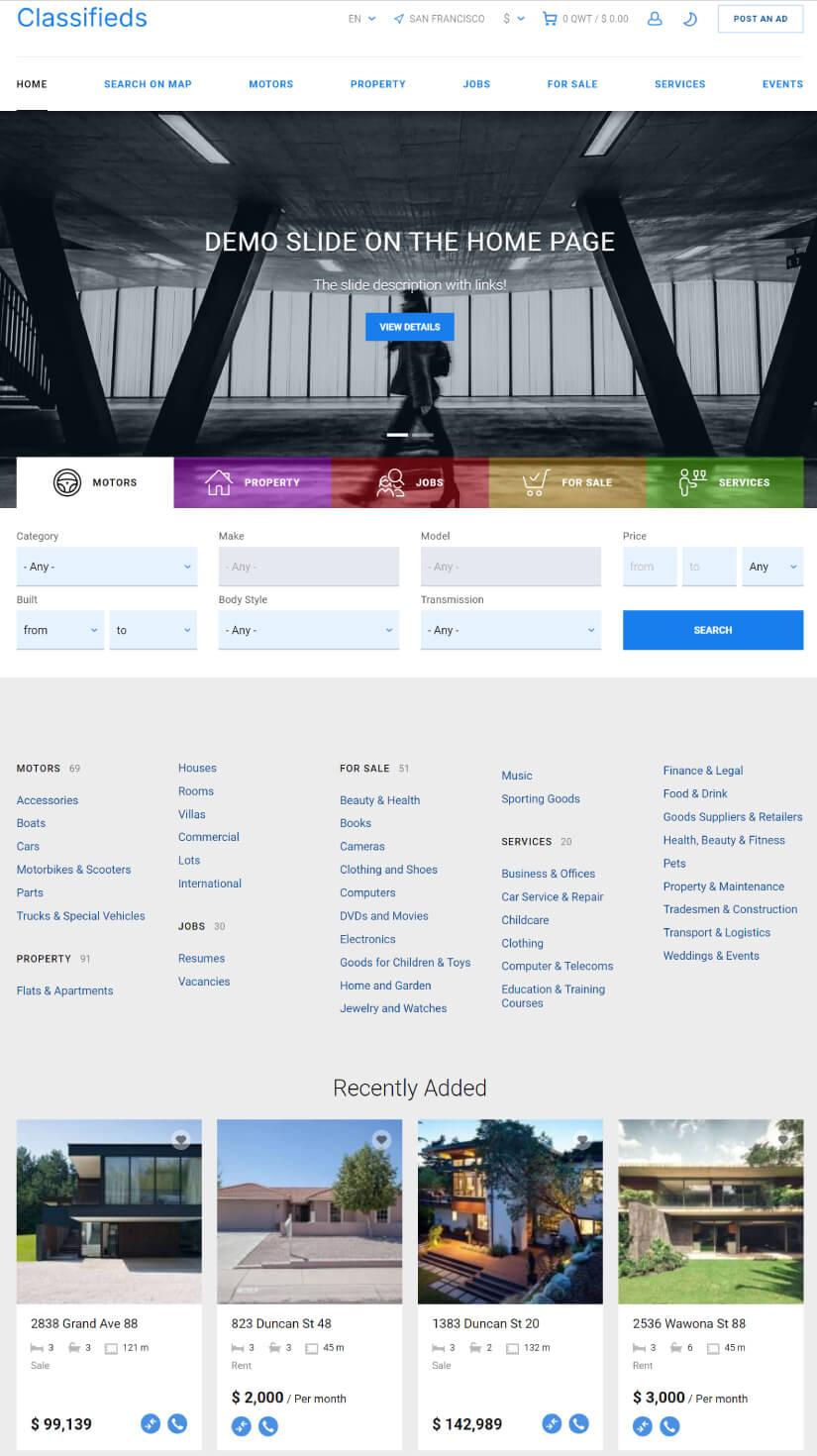
User-friendly interface
We provide an intuitive and user-friendly interface. It allows users to easily find the products they want and use all other features offered on the platform.
Marketplace security
We ensure a high level of security of marketplaces build on the basis of our CMS by encrypting data, protecting user directories and sessions, checking downloaded files, etc.
Mobile interface for the marketplace
Our PWA plugin, which serves as a wrapper for your site, can significantly increase the accessibility of your marketplace on mobile devices. The Plugin allows users to enjoy all the functions and options provided on your website using mobile devices. For example, he can easily view and purchase products while standing in line for a coffee or waiting to see a doctor.
Updating the script and plugins
We regularly update our script, plugins, and modules to ensure a high level of performance and stability of marketplaces created on the basis of Flynax.
License duration
You make a one-time payment for the marketplace CMS, apps, plugins, and templates and get a lifetime license for all the products. All subsequent updates and bug fixes are free.
We have listed the main advantages of our product above. Now let’s consider some of them in more detail, especially CMS functionality, our beautiful templates, and plugins and modules that perfectly complement the basic functions of the CMS.
Script functionality for launching a marketplace
Our script for marketplaces offers all the most important functions and features that a good marketplace is supposed to offer. It allows you to:
- Add listings with descriptions, photos and videos, edit and delete them when they are no longer relevant;
- Add and manage a number of categories, edit and delete categories, display them in category blocks on different pages of the site, create SEO-friendly URLs for categories, ensure that fields are inherited from other categories, customize the appearance of categories, etc.;
- Manage fields using a set of preconfigured fields or templates to add custom fields to listings, create interdependent fields where the values of one field depend on the selection of values in the previous field, assign products to various categories using corresponding fields, for example, “new” and “used”, etc.;
- Manage the search process by enabling quick and advanced search through the use of a variety of filters;
- Manage content using different blocks, for example, “Hot deals”, “Recently added products”, etc.;
- Monetize the resource using membership plans, listing packages, banners, etc.
The basic software functionality offers a number of features making Flynax one of the most feature-packed marketplace software. With the plugins, you get even more features and functions that you may add as you keep building your marketplace.
Listing Import. Fill your marketplace with listings by importing them in a CSV/XLS file or using XML feeds.
Similar Ads. You may display similar ads on the Listing Details based on certain criteria that you may set from the back end of your site.
Listing Reviews/Rating. Users can leave comments about listings and rate them (it allows you to create a product rating that helps users to make better purchase decisions).
Price History. The Plugin demonstrates the dynamics of the price history for the product and signals the most appropriate time to buy it.
Compare Listings. Buyers may select several products with similar characteristics and compare them in a convenient table.
Bookmarks and Share. Users can add listings to their bookmarks and share links to these listings with their friends or other people.
These, of course, are not all the plugins that we offer for a marketplace. In total, we offer 80+ various plugins and 42 of which are free.
Selling products and delivering them
The sale of products on a marketplace created based on our CMS is performed using our powerful Shopping Cart and Auction plugin. It allows buyers to buy products, and sellers to receive money for the products they have sold. The algorithm the buyer follows when making a purchase is pretty standard: the buyer adds an item to the shopping cart, indicates the place of delivery, and makes the payment. If you charge a commission on sales to monetize your marketplace, as soon as the payment from the buyer is received, the system calculates the amount of the corresponding commission and sends one part of the payment to the seller and the other one – to you, the site owner.
In addition to the sale of products through the shopping cart, you can provide sellers on your site with the opportunity to sell their products through an auction. An auction attracts more attention to the product and helps the seller to get a larger amount of money for it from the most interested buyer. The Auction module also allows the seller to:
- Set the initial price for his product,
- Enable adding bids automatically at certain intervals to stir up interest in the product,
- Enable the ability to buy the product at a fixed price (usually slightly higher than the initial price), bypassing the auction, etc.
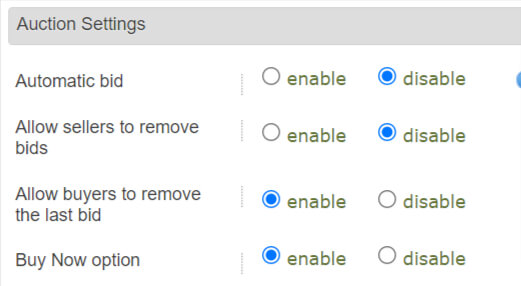
Besides, the Plugin allows you to configure the shipping methods. There are two ways to arrange the shipping:
- by courier service,
- by pickup.
The shipping costs can be both flat and flexible, depending on the delivery point.

You can also set a number of other parameters, such as:
- processing time,
- type of packing,
- product weight and its dimensions,
- provide a shipping discount, etc.
How to monetize your marketplace
There are several simple ways to monetize a marketplace.
Percentage/commission on sales
Charging commission on sales is perhaps the most common way to earn money on marketplaces. The commission, typically 3-15%, can be paid by the seller (the most common model), the buyer, or by both of them. However, if a marketplace sells expensive products (real estate property, cars, etc.) or it has nothing to do with money and sales (for example, sites for the free exchange of goods or services, employment sites, etc.), this method may not be applicable.
Within our script, this monetization method can be implemented using the Shopping Cart and Auction plugin, which offers a split payments option.
Subscriptions or membership fees
When you use this method of monetization, all or some users on your marketplace will have to pay for the ability to use it. This method is perfect for platforms that sell expensive goods, provide employment services, etc.
To implement this method of monetization, you can use membership plans offered in our CMS. You can create multiple plans with different options provided for users. For example, you can create a free plan that allows a user to add one standard listing with two or three photos, and a few premium plans offering to add multiple ads, both standard and premium ones, with a large number of photos, videos, and other useful options. The more option-rich plan you offer, the higher the price you will be able to set for it.
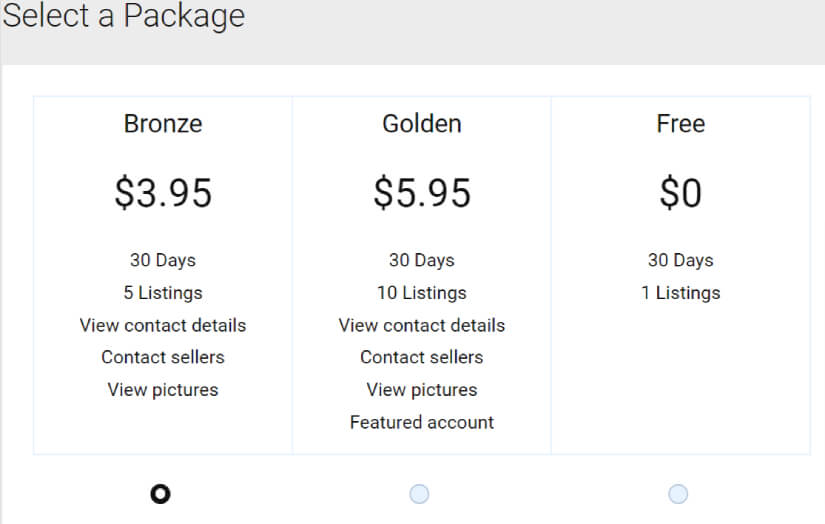
Listing packages
You can take money from sellers for placing listings on your marketplace. Just like with the membership plans, you can create a few listing packages and offer them to your sellers. You can sell premium listing packages to all sellers or those who sell certain products or services. For example, on a job search site, you may allow job seekers to offer their services for free, while employers will have to pay for adding listings for searching employees.
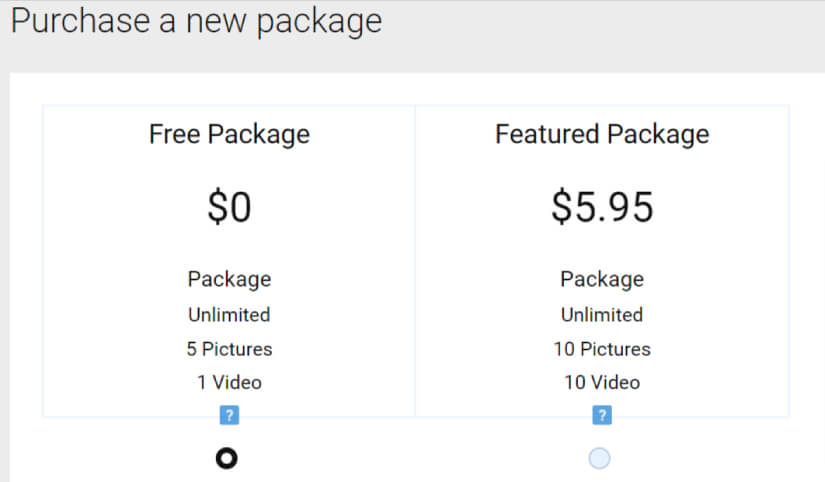
Ads in featured blocks/Bumping-up and highlighting listings
To make your marketplace more attractive, you may allow users to add their listings for free. At the same time, you may offer them to promote their listings by moving them to top positions or featuring them in separate blocks. In our script, you can do this by selling listing packages that include adding featured listings. These listings are usually displayed in the first lines of the feed and marked accordingly. A similar possibility to move ads to the top and highlight them with color is provided by our Monetizer plugin.
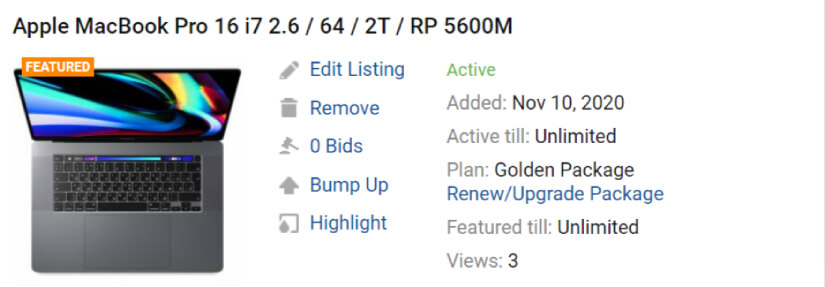
Selling banner space
Websites created on the basis of our CMS have a number of positions where you can place banners. To provide an opportunity for a seller or partner to place a banner on your site, you will need to create several banner packages offering various terms. You can do this with the use of our Banners plugin.

As you can see, there are several ways to monetize a marketplace. However, the most common and widely used one is taking a commission on sales. We highly recommend that you consider all the possibilities and choose the one that suits you best.
You can also combine the approaches. For example, take one of the above methods as the main method of monetization, and then combine it with others as your project evolves.
Payment gateways
A marketplace cannot properly function without payment gateways. In our CMS, they come in the form of plugins. We offer 19 payment gateways, including PayPal, CCAvenue, CCBill, SecurionPay, WalletOne, Stripe, and others. Some of them are versatile and work in almost every country in the world, while others are country- or region-specific.
We also have the CoinGate plugin that allows you to accept payments in bitcoins and other most popular altcoins. If your users cannot pay using any of the gateways mentioned above, you can use our Offline Payments plugin to accept payments using bank and money transfers.
How much do you have to pay for the marketplace CMS?
The price for our CMS has remained unchanged for many years – USD 195. After paying this amount, you get:
- a lifetime license,
- 42 free plugins,
- a free responsive theme,
- regular updates of the script, all plugins, bugfixes,
- all necessary manuals and instructions,
- 1 month of free support.
You may also purchase premium templates, additional plugins, basic SEO setup, mobile applications, and support packages – all at affordable prices.
As you can see, launching a marketplace is not an easy task, but it is quite feasible. The most important thing here is to choose the right CMS, because this is what determines the further success of your site. With the purchase of our marketplace script, you will gain access to extensive functionality, stylish templates, plugins, and support from a professional team ready to quickly and efficiently install and set up your marketplace site.









